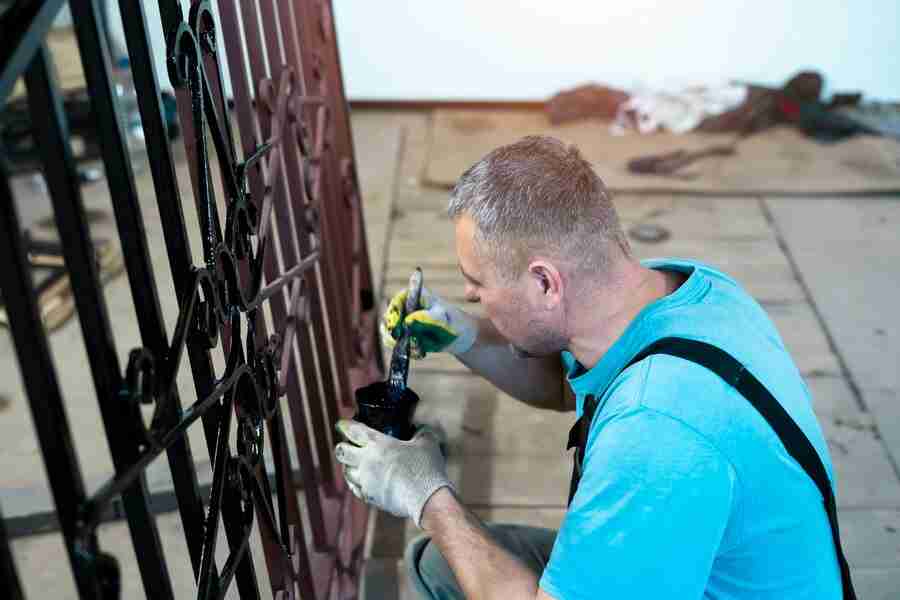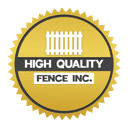Maintaining the integrity of your property’s perimeter is crucial for security and aesthetics. However, over time, even the most robust chain link fences can encounter wear and tear, leading to common issues such as sagging, rust, or broken links. Fortunately, addressing these problems doesn’t always require professional assistance. With the right tools and knowledge, you can undertake DIY fence repairs efficiently and cost-effectively.
In this guide, we’ll explore various techniques for fixing common chain link fence issues. From reinforcing sagging sections to treating rust and replacing damaged links, we’ll provide step-by-step instructions and helpful tips to empower homeowners to tackle these tasks confidently. With a bit of effort and attention, you can restore your fence’s functionality and appearance, prolonging its lifespan and enhancing the security of your property.
Understanding Chain Link Fence Anatomy
A chain link fence comprises several essential components, including the mesh, posts, rails, tension wire, and fittings. The mesh, typically made of galvanized steel, forms the main barrier, while posts provide structural support at intervals. Rails run horizontally between posts, connecting them and providing additional stability.
Tension wire is often threaded along the bottom and top edges of the mesh to reinforce it and prevent sagging. Fittings such as tension bands, brace bands, and tension bars secure the mesh to the posts and rails, ensuring a tight and secure installation.
Assessing Fence Damage: Identifying Common Issues
Before embarking on repairs, it’s essential to assess the extent of damage to your chain link fence. Common issues include sagging sections, rust, broken links, holes, tears, and loose posts. Inspect the entire length of the fence, paying close attention to areas prone to wear and tear, such as corners and gate openings.
Note any visible damage, including rust spots, bent or broken links, and areas where the mesh appears loose or compromised. This thorough assessment will guide your repair efforts and ensure you address all necessary issues effectively.
Tools and Materials You’ll Need for DIY Repairs
Undertaking DIY repairs on your chain link fence can be a rewarding task, but it’s essential to have the right tools and materials on hand to ensure success. Here are the essentials you’ll need:
Pliers and Wire Cutters:
- Pliers are versatile tools that can help you grip, twist, and manipulate various components of your fence.
- Wire cutters are essential for trimming excess wire and cutting through damaged sections of chain link mesh.
- With these tools, you can easily handle tasks such as removing old links and tightening tension wire.
Tension Bar and Come-Along or Fence Stretcher:
- A tension bar is used to stretch tension wire, ensuring it remains taut and properly secured along the fence line.
- A come-along or fence stretcher is indispensable for pulling the mesh taut during repairs, especially for fixing sagging sections.
- These tools provide the necessary tension and support to ensure a professional-quality repair job.
Post Driver and Level:
- A post driver allows you to firmly seat fence posts into the ground, providing stability and support for your fence.
- A level ensures that posts are installed upright and aligned correctly, preventing issues with the overall integrity of the fence line.
- With these tools, you can confidently install or replace fence posts with precision and accuracy.
Replacement Links, Tension Bands, and Brace Bands:
- Replacement links are necessary for repairing broken or damaged sections of chain link mesh.
- Tension bands and brace bands secure the mesh to the posts and rails, ensuring a tight and secure installation.
- Having an assortment of these components on hand ensures you’re prepared to address various repair needs efficiently.
With these tools and materials at your disposal, you’ll be well-equipped to tackle common chain link fence repairs with confidence and efficiency.
Repairing Sagging Sections: Strengthening Fence Tension
Sagging sections are a common issue with chain link fences, often caused by inadequate tension or damaged components. To repair sagging sections, start by identifying the source of the problem, whether it’s loose tension wire, stretched mesh, or weakened posts. Use a come-along or fence stretcher to pull the mesh taut, then adjust tension bands and tension wire as needed to secure it in place.
Reinforce sagging areas with additional tension wire or braces, ensuring the fence remains sturdy and upright. Regular maintenance of tension levels will help prevent future sagging and prolong the lifespan of your fence.
Dealing with Rust: Prevention and Treatment Techniques
Rust can compromise the structural integrity and appearance of a chain link fence if left untreated. To prevent rust formation, opt for galvanized steel components, which are coated to resist corrosion. Regularly inspect your fence for signs of rust, focusing on areas where moisture accumulates, such as joints and connections.
If rust is present, remove it using a wire brush or sandpaper, then apply a rust-inhibiting primer to prevent further corrosion. Finish with a coat of rust-resistant paint to protect the metal surface and enhance the fence’s appearance. Periodically check for any signs of rust recurrence and address them promptly to maintain your fence’s durability and aesthetics.

Replacing Broken or Damaged Links
Broken or damaged links compromise the integrity of a chain link fence, making it susceptible to further deterioration. To replace these links, start by removing the damaged section using wire cutters or pliers. Then, attach new links by threading them through the mesh and securing them with tension bands or brace bands.
Ensure the replacement links are the correct size and gauge to match the existing mesh for a seamless repair. Regularly inspect the fence for any signs of damaged links and replace them as needed to prevent larger issues from developing over time.
Patching Holes and Tears in Chain Link Mesh
Holes and tears in the chain link mesh can compromise the fence’s security and appearance. To patch these areas, cut a piece of galvanized steel wire mesh slightly larger than the damaged area. Use wire ties or galvanized steel wire to securely attach the patch to the surrounding mesh, ensuring it is flush and tightly secured.
Trim any excess wire and smooth out the repaired area to blend it seamlessly with the rest of the fence. Regularly inspect the fence for any signs of damage and patch holes or tears promptly to maintain its integrity and security.
Securing Loose Posts: Techniques for Stability
Loose posts in a fence can compromise its stability and pose safety risks. Here are four effective techniques to ensure your fence remains secure:
- Digging around the base: Use a shovel to excavate soil around the post, exposing its base for inspection. Adjust the post’s position and ensure it is firmly seated in the ground before backfilling with soil.
- Reseating the post: Utilize a post driver to firmly re-seat the post into the ground. Ensure the post is vertically aligned and level before compacting the soil around it to provide stability.
- Adding concrete support: Pour concrete mixture around the base of the post to provide additional stability. Ensure the concrete is properly compacted and extends below the frost line to prevent frost heave.
- Installing support braces: Attach metal support braces to the post and nearby fence rails for reinforcement. Tighten the braces securely to prevent movement or shifting of the post.
Implementing these techniques will help secure loose posts and maintain the stability of your fence for years to come.
Enhancing Fence Durability: Maintenance Tips
Regular maintenance is essential for preserving the durability and longevity of a chain link fence. Routinely inspect the fence for signs of damage, rust, or wear and address any issues promptly. Keep the fence clean by removing debris and vegetation that can trap moisture and cause corrosion. Trim nearby vegetation to prevent it from encroaching on the fence and causing damage.
Additionally, periodically check the tension of the fence and adjust it as needed to ensure it remains taut and secure. By staying proactive with maintenance tasks, you can extend the life of your chain link fence and minimize the need for costly repairs.
Final Touches: Painting and Finishing for Aesthetic Appeal
Once repairs are complete, consider adding a fresh coat of paint to enhance the fence’s appearance and provide additional protection against rust and corrosion. Choose a paint color that complements your property’s aesthetic and ensure it is suitable for outdoor use. Before painting, clean the fence surface thoroughly to remove any dirt, rust, or debris.
Apply a rust-inhibiting primer to prevent corrosion, then follow with multiple coats of exterior-grade paint for lasting durability. Take care to apply paint evenly and allow sufficient drying time between coats. Once the paint is dry, step back and admire your handiwork, knowing that your DIY fence repairs have not only restored function but also added a touch of aesthetic appeal to your property’s perimeter.
Maintaining a sturdy and aesthetically pleasing chain link fence is achievable with the right tools, knowledge, and commitment to regular maintenance. By understanding the anatomy of your fence and identifying common issues, you can confidently undertake DIY repairs to address sagging sections, rust, broken links, and other damage. Remember to use high-quality materials and follow proper techniques to ensure long-lasting results. Additionally, implementing preventative measures such as rust treatment and regular inspections can help extend the lifespan of your fence and minimize the need for future repairs. With these strategies in mind, you can enhance the security and curb appeal of your property while enjoying the satisfaction of a job well done.
For professional assistance or to explore options for upgrading your fence, contact High Quality Fence at 209-815-9015 or email us at info@highqualityfence.com. Our team is dedicated to providing top-notch fencing solutions tailored to your needs. Take the first step towards a stronger, more attractive fence today!


